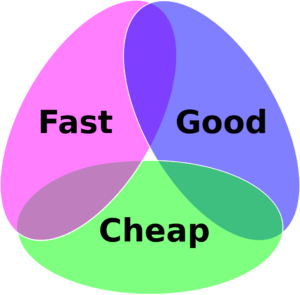

Why LESS is More When Sales Wants Leads
Your sales team thinks that it needs more leads. So, you ask marketing to generate more and more that you think will help grow your sales pipeline and ultimately your bookings (and revenue). But does it really matter whether you get 1,000 leads or 100 leads if the output of both sets of leads is the same – let’s say both sets generate 2 customers or $20,000 in bookings this year (assume a $10,000 deal size for your $ACV, the annual contract value). In fact, in this case, it makes more economical sense for your reps to work on fewer leads, because there are high Customer Acquisition Costs associated with qualifying too many leads and running too many sales cycles and thus, in this case, less is more. Let’s look at the metrics – and the Excel spreadsheets below – to see how this works.
Let’s assume your junior sales reps who qualify your marketing leads (sometimes known as Marketing Qualification Reps or MQRs) are making $40k per year (and fully loaded, assuming an additional 20%, he or she costs $48k annually to your company or $4k monthly). Then, this junior rep hands off your marketing leads to your Inside Sales Representative (ISR) who runs sales opportunities (sales cycles) and is making $80k base per year (and fully loaded at 20%, it will cost your company $96k per year or $8k monthly). For this calculation we assume a typical capacity of 400 marketing leads per MQR per month and a typical capacity of 25 sales cycles that your ISR can run per month to be effective at his or her job.
(Please click on the screenshots below to open up the downloadable Excel spreadsheet with tabs showing our calculations for 1,000 leads and 100 leads.)
Example 1: 1,000 leads
For your junior reps to qualify 1,000 leads means that you need 2.5 reps – if you have a maximum capacity of 400 per month and divide that by 1,000, then you need 2 full reps and half of the time (.5) of the third rep’s time this month to work on these. The cost is 2.5 x $4,000 monthly fully-loaded cost of a junior lead qualification rep, or $10,000 cost this month to your company.
Now that your leads are qualified, you need your senior Inside Sales Reps (ISRs) to run those that converted to opportunities to close them. Let’s assume that you convert 10% of these leads to opportunities and thus, you get 100 opportunities (10% x 1,000 leads) which need to be managed. As we state above, your ISRs can effectively run about 25 opportunities or sales cycles per month, and this means that you need 4 of your ISRs to work on the 100 newly created opportunities (i.e. 25/100 = 4). Therefore, the cost to your company is $32,000 this month (4 x $8,000).
At this point, your total Sales $CAC is $42,000 (or $10,000 for junior lead qualifying reps and $32,000 for the senior ISRs). If your marketing program cost $100,000 to generate these 1,000 leads, then add this amount to the Sales $CAC and thus, your total $CAC is $142,000.
And if you convert to 2 customers this year, and assuming (as mentioned in the intro paragraph) that your $ACV is $10,000 and also that your customers will be around for 4 years, then your LTV per customer is $40,000 and for 2 customers, it is $80,000. In this case, your LTV:CAC ratio is $80,000/$142,000 or about .6x, which is not good (ideally, LTV:CAC should be >3x).
In summation:
-
Program Cost to generate 1,000 leads = $100,000
-
2.5 Lead Qualification Reps, Cost = $10,000
-
4 Inside Sales Reps, Cost = $32,000
-
Total Customer Acquisition Cost ($CAC) = $142,000
-
$ACV = $10,000
-
$Bookings = $20,000
-
LTV = $40,000 per customer
-
LTV:CAC Ratio = .6x
Example 2: 100 Leads
In this case, your marketing generates 1/10 of the leads, and these 100 leads cost you only $10,000 instead of $100,000 as in the case above. But these are better quality leads and their conversions will be significantly higher – assume we have 10x better conversion from leads to customers, and therefore you still get the same 2 customers this year from these leads.
In this case, you will only need 25% of the time of only 1 junior sales rep to qualify 100 leads (100/400 = .25) unlike the 2.5 of your junior reps that you would need to work 1,000 leads, as shown in the previous example. Thus, the cost to your company is only $1,000 this month. You will also need just 40$ of your senior Inside Sales Rep’s time (10 opportunities / 25 capacity) so this time will cost you only $3,200 this month. Your total Customer Acquisition Cost is now only $14,2000.
In summation:
-
Program Cost to generate 100 leads = $10,000
-
.25 of your Lead Qualification Rep’s Time, Cost = $1,000
-
.4 of your Inside Sales Rep’s Time, Cost = $3,200
-
Total $Customer Acquisition Cost ($CAC) = $14,200
-
$ACV = $10,000
-
$Bookings = $20,000
-
LTV = $40,000 per customer
-
LTV:CAC Ratio = 5.6x
As you can see, your LTV:CAC in the second example is much better and hence, to grow your business efficiently and effectively, you need to make sure that you are getting leads using low customer acquisition strategies and you must optimize the Lifetime Value (LTV) to Customer Acquisition Cost ratio. If your LTV:CAC is over 3x, then your marketing team is doing a good job.
Can’t Marketing Just Generate More Sets of These “100 Leads”?
Of course, as a sales manager, you may have marketing that needs more sets of these high quality leads. But generating quality leads (typically called more qualified leads or MQLs) is not a simple matter. In this case, marketing will need to obtain a much larger budget because running demand generation programs and getting many high quality leads comes at a cost. There is always a higher cost to getting more high-quality leads that convert. And these leads take more time – marketing can’t just magically generate the types of leads that wish to buy immediately. Thus, your company will need to invest a lot more dollars in marketing – both into marketing programs (variable budget) and in hiring more for the marketing team to execute differently (fixed budget).
For every lead generation program, there are 3 basic constraints: Quality, Time and Cost. Looking at the Euler Diagram below, one can recall the old adage: “Fast, Good, Cheap – pick 2.” Unfortunately, you can’t optimize for all 3 simultaneously, which is why they don’t all intersect in the diagram below.
The bottom line?
Fewer leads of higher quality and with better conversion rates will reduce the activities your reps need to complete per opportunity and sales cycle, and ultimately improve your sales team’s ability to sell more effectively.
Suspicious of the “less is more” approach to leads? Have you put your marketing qualified leads under a microscope to reduce quantity and increase quality? Share your thoughts and please feel free to email us if you have any questions or if we can be of help in your decision to run analytics on your sales and marketing performance.

